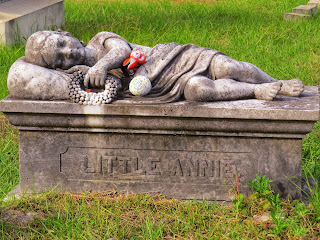Come November at Charleston’s Magnolia Cemetery you can always count on seeing Hooded Mergansers (“Hoodies” for short) wading in one or both of the ponds.
That was the incentive to visit Sunday afternoon. But, alas, the colorful Hoodie was not to be seen. Maybe they are running late in their southern migration. We’ll have to return in a few weeks to see. Meantime, to see these darling wading birds click on the embedded link above that will take you to a previous post of mine.
 This day on the water the only bird I saw was this Pied-billed Grebe. This is a small wading bird that seems very shy, often diving under the water if a human is spotted.
This day on the water the only bird I saw was this Pied-billed Grebe. This is a small wading bird that seems very shy, often diving under the water if a human is spotted.But there were birds elsewhere to be seen and photographed!
The good news was there was bird activity elsewhere at Magnolia cemetery including on the hangout tree shown above. White Ibis and a single Wood Stork perched side by side. I took these photos from the white bridge that crosses over the front pond. Other birds to follow, starting with Snowy Egrets spotted in a few locations.
It was also enjoyable to see the rich variety of grave markers at this necropolis that dates to 1850.
The Snowy Egret is known for its distinctive yellow “slippers.”
The much larger Great Egret in the salt marsh.
A Belted Kingfisher captured from long range.
An Anhinga spreads its wings
Up in the sky an Osprey (I think) looking for a fish meal perhaps.
A few favorites among visitors are adorned with flowers, toys, coins, even a small box of cereal (Frosted Flakes).
"Little Annie" Kerr Aiken was a month shy of her third birthday when she died in 1856 of diphtheria, a throat disease.
Little Annie's grave is in the large fenced Aiken and Martin family plot located near the back lagoon or pond.
Just 7-months-old Rosalie Raymond died in 1882 cyanosis, the "blue disease" that involves circulatory or ventilatory problems in the lungs.
The face is believed to be a death mask of Baby Rosalie. I've always thought it resembles the face on Gerber baby food.
Nice touch whoever brought Tony the Tiger to the gravesite!
Other grave marker standouts at Magnolia Cemetery include this large monolith marker framed by Spanish moss. This marks the graves of Jonathan Shaw (1830-1894) and (most likely) his wife Caroline Lynch Shaw (1834-1905)
In case you do not know, dear reader, I have written two books about the special place Magnolia Cemetery. Links to them are at the top of this website. This is how I know the sad stories of Rosalie Raymond and Annie Aiken who I write about, among with many other "residents" here in my 2014 book, "In the Arms of Angels: Magnolia Cemetery-Charleston's Treasure of History, Mystery and Artistry." (available on Amazon, at select Charleston stores and shops, and from me directly).
As many times as I’ve been here and taken thousands of pictures I always seem to be discovering gravesites and sometimes birds I have never seen or noticed before. It really is a neat place to explore. On this Sunday afternoon there were quite a few other people visiting which was nice to see.
The three photos above and the two to follow are in the cemetery's Green Hill section (which used to be a golf course around 1900!). There is a new section of gravesites seen below. It is nice to see the creativity people today have to remember lost loved ones.
Below is the impressive Hugh Swinton Legare monument that dates to 1857. A lawyer and high level political figure at the state and federal level, Legare, who died in 1843 at 46-years-old, was first buried at Mt. Auburn Cemetery near Boston. This was America's rural Victorian cemetery in the style that Magnolia Cemetery would follow. Thirteen years after his death, his remains were disinterred from Mt. Auburn and brought home to Charleston. This, again, is a story I tell in detail in my book.






























No comments:
Post a Comment